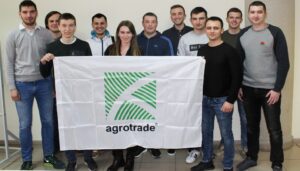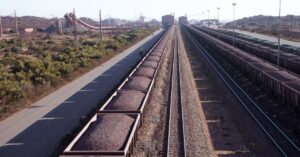
In the 2025 season, Agrotrade agricultural holding intends to lay down and conduct 370 trials of new varieties and hybrids, nutrition and crop protection systems, its press service reported on Facebook.
“We are constantly improving our technologies to get the best solutions for growing crops. New varieties, optimal nutrition and protection schemes – all this helps us to increase yields and product quality,” said Yuriy Fadeev, R&D specialist at Agrotrade.
The agricultural holding noted that it will conduct 218 tests of new varieties and hybrids, including corn, sunflower, soybeans, winter wheat, winter rapeseed, industrial hemp and peanuts; 30 studies of nutrition and fertilizer standards; 122 tests of plant protection technologies.
This year’s testing area will increase by 20% compared to last year. The agricultural holding will traditionally sow fields in Chernihiv, Sumy and Kharkiv regions.
It will also expand cooperation with international partners and focus on improving digitalization of trials and accounting methods. In addition, new nutrition technologies will be tested for the first time, including liquid mineral fertilizers and plant protection.
Agrotrade Group is a vertically integrated holding company with a full agro-industrial cycle (production, processing, storage and trade of agricultural products). It cultivates over 70 thousand hectares of land in Chernihiv, Sumy, Poltava and Kharkiv regions. The company’s main crops are sunflower, corn, winter wheat, soybeans and rapeseed. It has its own network of elevators with a one-time storage capacity of 570 thousand tons.
The group also produces hybrid seeds of corn and sunflower, barley, and winter wheat. In 2014, a seed plant with a capacity of 20 thousand tons of seeds per year was built on the basis of Kolos seed farm (Kharkiv region). In 2018, Agrotrade launched its own brand Agroseeds on the market.
The founder of Agrotrade is Vsevolod Kozhemiako.

The United Arab Emirates (UAE) will invest $1.4 trillion in the US economy over the next 10 years, the White House said in a statement. The investment plans were announced after US President Donald Trump met with UAE National Security Advisor Sheikh Tahnoon bin Zayed Al Nahyan this week.
“The new plan envisages a significant increase in the UAE’s current investments in the US economy, particularly in AI infrastructure, semiconductor and energy industries, as well as in the US industrial sector,” the statement said.

The residential real estate market in Montenegro in 2024 showed a significant increase in prices for both apartments and houses. The average cost of housing in new buildings increased by 20%, reaching EUR 1,844 per square meter.
Experts predict continued growth in real estate prices in Montenegro in 2025, especially in areas with developed tourist infrastructure. Demand for luxury properties in coastal areas is expected to remain high, leading to further price increases.
Buyers are advised not to postpone their decision to purchase real estate, given the current market trends.

Rains are expected on the night of March 23 in Zakarpattia and Ivano-Frankivsk regions, and on Sunday afternoon in western, Zhytomyr and Vinnytsia regions, while the rest of Ukraine is expected to be without precipitation, the Ukrainian Weather Center reports.
Southeast wind, 7-12 m/s, gusts of 15-20 m/s during the day in Rivne, Khmelnytsky, Chernivtsi, Zhytomyr, Vinnytsia and Kyiv regions. Temperatures at night will be from 1° below zero to 4° above zero, in Transcarpathia and Prykarpattia 1-6° above zero; during the day 9-14° above zero, in the Carpathians 5-10° above zero.
No precipitation in Kyiv on March 23. Southeast wind, 7-12 m/s, gusts of 15-20 m/s during the day. The temperature will be 1-3°C at night and 11-13°C during the day.
According to the Borys Sreznevsky Central Geophysical Observatory. Borys Sreznevsky Central Geophysical Observatory, in Kyiv, for the entire period of observation on March 23, the highest daytime temperature was 20.4°C in 1913, the lowest nighttime temperature was -17.3°C in 1942.
On Monday, March 24, moderate, sometimes heavy rains are expected in the western and northern regions, light rains in most of the central, Odesa, and Mykolaiv regions, and no precipitation in the rest of the country.
Southeast wind, 7-12 m / s, during the day in Ukraine, except for most of the western and eastern regions, gusts of 15-20 m / s. The temperature will be 2-7° Celsius at night, 9-14° Celsius during the day, 11-16° Celsius in the southern and central regions.
It will rain in Kyiv on March 24. Southeast wind, 7-12 m/s, gusts of 15-20 m/s during the day. The temperature at night will be 4-6° Celsius, during the day 11-13° Celsius.

Mass protests continue in Turkey after the detention of Istanbul Mayor Ekrem Imamoglu, one of the main political opponents of President Recep Tayyip Erdogan; on Friday alone, 343 demonstrators were detained in nine cities, including Ankara and Istanbul, Radio Liberty reports, citing the Turkish Ministry of Interior.
Interior Minister Ali Erlikaya accused the demonstrators of trying to “disrupt public order and provoke chaos.” In addition to the protesters, 56 other people were detained separately for allegedly inciting unrest through social media.
Imamoglu was detained in the morning of March 19. He and about 100 other people were accused of corruption crimes and the creation of a criminal group that was engaged in extortion from businesses.
Imamoglu, whom the Republican People’s Party (CHP) is preparing to nominate as a presidential candidate, called the case politically motivated. On social media, he said the investigation was a “political coup” and called on citizens to fight back.
The Turkish Ministry of Justice claims that the case has no political basis.

In January-February of this year, Ukrainian mining companies reduced exports of iron ore in physical terms by 1.2% compared to the same period last year, to 5 million 595.706 thousand tons.
According to the statistics released by the State Customs Service on Tuesday, foreign exchange earnings from iron ore exports decreased by 18.7% to $449.388 million during this period.
Exports of iron ore were carried out mainly to China (46.50% of supplies in monetary terms), Poland (17.35%) and Slovakia (14.31%).
In January-February 2025, Ukraine imported iron ore worth $1 thousand in the amount of 5 tons from Italy.
As reported, in 2024, Ukraine increased its exports of iron ore by 89.8% compared to 2023 – up to 33 million 699.722 thousand tons, while foreign exchange earnings increased by 58.7% to UAH 2 billion 803.223 million.
In 2024, Ukraine imported iron ore for $414 thousand in a total volume of 2,042 thousand tons, while in 2023, 250 tons of this raw material were imported for $135 thousand.
In 2023, Ukraine decreased exports of iron ore in physical terms by 26% compared to 2022 – to 17 million 753.165 thousand tons, foreign exchange earnings from iron ore exports amounted to $1 billion 766.906 million
(down 39.3%). In 2023, Ukraine imported iron ore worth $135 thousand in a total volume of 250 tons.